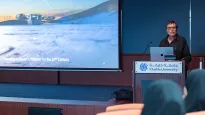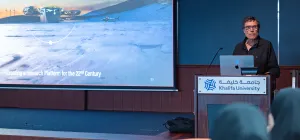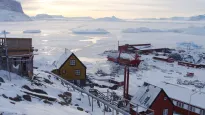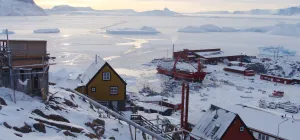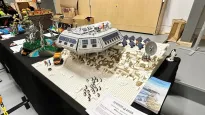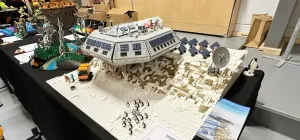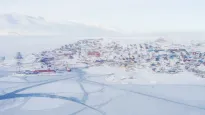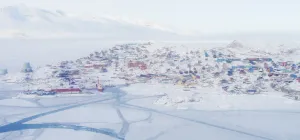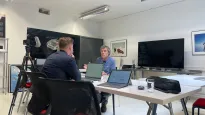Jan Lenaerts on field expedition plans for BENEMELT and IceCon projects

As the winner of the 2014 InBev-Baillet Latour Antarctic Fellowship, the largest research grant awarded to young polar researchers, Dr Jan Lenaerts from Utrecht University in the Netherlands will be spending several weeks away from the Princess Elisabeth station at the King Baudoin Ice Shelf on the coast conducting research for the BENEMELT project.
Accompanying Jan will be several scientists from the Université Libre de Bruxelles (ULB) who are working on the IceCon project, as well as fields guides and mechanics to provide logistical support.
Before his departure, we asked him about the planned research program over the next three weeks.
What is the objective of the BENEMELT research project you're working on?
The BENEMELT project seeks to study snow melt on the surface of the ice shelf and how this affects the ice shelf's stability. As a floating platform of ice connected to the ice sheet, an ice shelf is an extension of ice flowing off the surface of the Antarctic continent and out to sea. Any weakening of the ice shelf from melt will likely result in an increase in the amount and speed of ice flowing off of the Antarctic Ice Sheet and into the ocean, which will ultimately contribute to sea level rise. So the research I'm doing has global implications, especially for low-lying coastal areas such as Belgium and the Netherlands.
How have preparations for the expedition at the coast been going?
Ever since we arrived last week, we've been busy making all the necessary preparations for departure. We’ve done the field security training, crevasse training, and skidoo training. We've also been unpacking and testing all our equipment, and the cook has been preparing enough ready-to-eat meals for us to last three weeks.
What is the plan for the first leg of the field expedition?
The first thing we need to do is make the journey from the Princess Elisabeth station to the coast, about 200 km away. We'll be at least 10 people, so we'll be quite a large group. We expect the journey to take at least 20 hours since our living/working containers will be pulled by Prinoths that can only drive 10-20 km/h.
Our first stop will be Derwael Ice Rise, which is on the eastern side of the King Baudoin Ice Shelf. Here. Here we'll set up our first field camp. Over several days, we'll take radar images of the ice below the surface at the ice rise and do two ice core drillings for the IceCon scientists.
They are interested in studying the variability in the snow accumulation on the ice shelf over the past few decades. The radar profile they plan to do will provide a profile of the ice sheet layers, and from the ice cores, it will be possible to identify from the different layers of the ice core how much snow accumulated from year to year, and to what extent it melted. And that’s exactly what I’m also interested in, so in this way we combine forces between IceCon and BENEMELT.
Since their radar is able to penetrate the entire ice shelf, we'll be able to see how thick the ice shelf is. The IceCon scientists want to take ice cores at the places where the ice shelf is thinnest, which are usually pinning points (where a feature like a rock or small island protrudes upwards from the sea floor and touches the bottom of the ice shelf, slowing to some extent the flow of the ice in the ice shelf towards the ocean).
Why do you want to undertake two ice core drillings?
One ice core will be taken on the western side of the ice rise divide and one on the eastern side. It's important to take two ice cores to compare them because snow accumulation on the ice rise can vary a lot from one place to another, and the ice cores will help us understand just how much that variability is.
In the ice cores that we'll be drilling, we'll be able to see the yearly layers of snow accumulation (each layer corresponds to one year of snow accumulation) over the past few decades. But in between these yearly layers, you can also see how much the surface of the snow was melting from year to year. So we'll have a record of past melt on the ice sheet that we'll be able to use to improve our models.
Derwael Ice Rise is higher than other parts of the ice shelf, so it's colder in summer, and therefore we expect the surface melt will be less compared to areas further down the ice shelf towards the coast.
Where will you head next?
After about a week on the ice rise, we'll head out onto the ice shelf and set up our second camp not too far from the coast. We'll also take more radar images and another ice core like we did on the ice rise.
Once we've finished, we'll head back inland towards the continent making a 70 km north to south transect between the coast and the grounding line (the point where the ice shelf begins at the edge of the continent).
Along this transect, the IceCon scientists will take radar measurements, and I plan to extract several shallow firn cores from the surface of the ice shelf (Firn is a transition state between fresh snow and ice, just below the snow on the surface). The firn coring device can only go a few metres deep, unlike the ice coring drill the IceCon team is using, which can go much deeper. But I only need 10 or 20 years worth of snow accumulation data for my project, so it's not a problem.
How many firn cores do you hope to take? And why take them along a transect?
I can't say how many firn cores I'll take along this 70 km transect. It will depend at lot on the weather and how much time we have. Suffice it to say we'll take as many as possible.
While taking one firn core will tell me how melt has varied over the past 10 or 20 years in that location, taking cores over a straight-line transect will show how surface melt varies from place to place.
Will you be taking any other measurements?
I also brought an instrument to measure the albedo (reflectivity) of the snow surface. I hope to measure the surface albedo of the ice shelf at various points along the transect. The instrument measures both the amount of incoming radiation from the sun and the amount of radiation the snow reflects, and the ratio between these two measurements is the snow's albedo.
Why is it important to measure the snow's albedo?
Measuring the snow's albedo is important in studying its melt, because it determines how much and how fast the snow will melt. Freshly fallen snow has a very high albedo, and reflects most of the sun's incoming radiation back into space. But once the ice melts, it becomes darker. As we know from high school physics that darker materials absorb more solar radiation than lighter ones do, the melting ice absorbs even more radiation and melts even more, creating a feedback loop.
We're also using satellites in the BENEMELT project, and satellites can measure a snow's albedo form space over a very large area. But it's important to take measurements on the ground to make sure the satellites are properly calibrated.
What happens once you get to the grounding line of the ice shelf?
The most important task I need to complete this season is installing an automatic weather station (AWS) at the ice shelf's grounding line. The AWS will be my main source of data for this season. Once set up, it will transmit data to a satellite, so I'll continue to be able to receive weather data from the ice shelf after I return from Antarctica. We hope to keep it there at least until I return next season so we have weather data at the ice rise for a period of one year.
The AWS data is some of the best data I'll be getting during the BENEMELT project, because it provides high-quality meteorological measurements. By combining all these measurements, I can calculate the surface melt very accurately.
What will you do with all the data you're collecting?
Once satellite data is calibrated, I can use the data for comparison with our climate models that try to see how variation in albedo influences variation in snow melt over a large area. And from the ice and firn cores along with the radar data form the IceCon project, we'll be able to see how the snow melt varies from year to year over a given area. We won't be able to get quantitative data on the firn core layers, but we'll be able to do a qualitative study of them, to see how melt varied form year to year.
We'll be able to get the best quantitative data from the AWS, though, as it will track all meteorological conditions that determine the surface energy balance of the ice sheet. And we know which conditions need to be met in order for melt to occur. It would be nice to have ten weather stations all over the ice shelf, but we just don't have the money for that. But at least we'll have lots of quantitative data from one site and extrapolate the information we have on this one area to other areas where we're taking measurements, but won't have weather data available.
So in the end, the goal is to connect albedo variability to snow melt variability over time over on the King Baudoin Ice Shelf. The albedo feedback is subtle yet extremely important in this part of East Antarctica. If the albedo of the snow decreases, then this will create a feedback loop that will lead to further melting, and this feedback mechanism will reinforce itself if we have a warmer climate.
Do you have any hypotheses about what you might find?
From satellite data, it appears that there's little snow melt in the middle of the ice shelf. But in the north, close to the ocean, there's much more melt because it's usually warmer near the coast. But we expect to have the most melt in the vicinity of the grounding line.
The reason for this is very interesting. There's a rapid descent as you come down off the ice sheet and onto the ice shelf, and at this steep gradient you have a lot of cold, katabatic winds coming from the interior of the continent. Above the flat ice shelf, this cold, heavy air accumulates above the snow surface, forming a strong temperature inversion with the coldest temperatures just above the surface.
However, along the interface between ice sheet and ice shelf, the warmer air above can more easily entrain into the temperature inversion, breaking it down and causing higher surface temperatures and more surface melt. But this is just a hypothesis; our measurements will either confirm or refute this.
So the temperature gets above freezing at the surface of the ice shelf at times?
By definition, surface melting occurs when the temperature at the surface of the ice shelf is 0°C or more. The average temperature on the ice shelf year-round is below 0°C, even in summer.
However there are certain conditions in summer under which ice melt can occur, although these conditions don't occur very frequently. But when they do - even if it gets to 0°C for only a few hours of one day - it starts the albedo-melt feedback cycle: lower albedo leads to further melting, because once the snow has been melted, it becomes darker, and will absorb more solar radiation the next time the temperature gets warm enough. So once there's been an initial melt, the likelihood of further melting to occur increases.
What will be your living quarters while you're out in the filed?
We'll be living partially on the skidoos (while we're on the move, of course), partially in the two containers, and partially in tents. Some of us will sleep in the containers, using sleeping bags and mats. Those in the group who don't mind sleeping outside in -20°C will take their sleeping bags and sleep outside in the tents. That way we won't be too crowded. I wouldn't mind sleeping outside in a tent myself.
We'll use the containers as a place to prepare and eat our meals. It can also serve as a place where everyone can find shelter in case the weather gets bad. With an area of about 20 square metres, they're about the size of a small apartment, although they're not luxurious. But that's part of the adventure.
Overall, how do you find the quality of the logistical assistance you're receiving for the BENEMELT project?
I'm very impressed by the material that's available and the logistics that are available to us scientists here at the Princess Elisabeth station. They've done everything they can to help us get ready and make sure we have everything we need.
Do you think you'll be able to accomplish everything you set out to do this season?
I think it's a realistic work program, and we can be quite flexible with time. We' should be able to get everything done, if the weather co-operates. The AWS should only take a day or two to set up, so once we've finished that, I hope to perhaps do another firn core transect, but this time from east to west. It would be nice to get an idea of both north-sound and an east-west variability of surface melt on the ice shelf.
Even if we only end up taking five firn cores along the north-south transect, this will be sufficient for the purposes of the research project. However by combining the data collection efforts of the IceCon and BENEMELT projects this season, we save time and maximize efficiency.
I feel very positive about this field season, especially if the weather stays good. It's cold, but sunny. And if the weather stays clear like this at the coast, there's greater chance to see snow melt on the surface of the ice shelf.
When do you expect to return from the field expedition?
We plan to be back at the Princess Elisabeth station sometime between December 14th and 16th. That will give us enough time to pack all our equipment up before we head back home for Christmas.
You can follow Jan's adventures during the BENEMELT project on his blog.
You can also follow the work of the IceCon team on their blog.
Download












